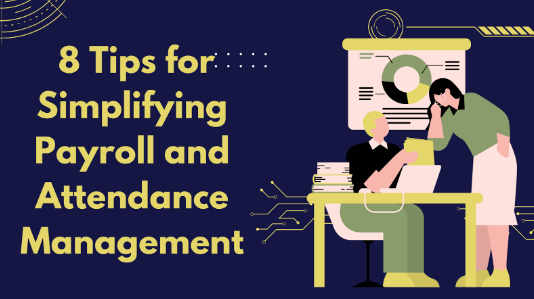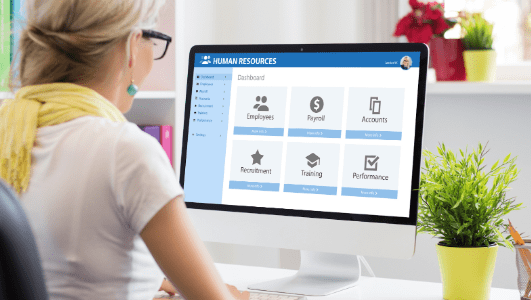
Efficiently managing payroll and attendance is vital for any organization, but it can often be time-consuming and complex. Businesses face numerous challenges in this critical area, from accurately tracking employee hours to calculating salaries and complying with ever-changing regulations. However, simplifying payroll and attendance management has become more achievable with modern technology and streamlined processes.
In the ever-evolving business landscape, simplifying payroll and attendance management is no longer a luxury but a necessity. By embracing technology and adopting streamlined processes, organizations can free up valuable time and resources, allowing them to focus on more strategic initiatives and creating a positive work environment for their employees.
Why Payroll and Attendance Management is a Challenge?
Organizations face a variety of payroll and attendance issues that plague them. Keeping track of employee attendance can be challenging, especially in large or dispersed organizations. Paper time sheets and manual data entry could be more efficient and prone to error.
Tracking attendance is complicated by fluctuating schedules, remote employees, and rotating shifts. Using time-capture devices or mobile applications to automate this process can improve its accuracy and efficacy.
Payroll calculation and processing are complicated processes that require a great deal of skill. The payroll consists of regular and overtime hours, deductions for leave and absence, taxes, benefits, and deductions. To ensure timely and error-free employee compensation, these components must be precisely managed by tax regulations and other requirements.
Complicated overtime calculations, varied employee pay structures, and fluctuating labor laws can lead to complications. Payroll automation systems can overcome these obstacles by automating computations, allowing programmable rules, and integrating with other HR software.
Importance of Efficient Payroll and Attendance Management
To monitor employee attendance, automated attendance tracking employs sophisticated technology and software. Payroll software streamlines operations, eliminates manual data entry, and reduces errors.
To accurately record clock-in, clock-out, pauses, and absences, the software can interact with time clock systems, biometric devices, and employee self-service portals. This automation saves HR personnel time and guarantees accurate attendance records for auto-payroll calculations and compliance with labor laws.
Automating attendance monitoring is advantageous for businesses. Eliminating paper attendance forms and manual timekeeping increases productivity and decreases administrative costs. The software generates real-time attendance reports to monitor the punctuality and absenteeism of staff members.
Additionally, it helps businesses identify attendance patterns and address problems. Automated attendance monitoring eliminates errors and discrepancies between reported and actual work hours. Automating attendance monitoring expedites processes, improves accuracy, and ensures fair and compliant attendance management.
Payroll Software for Simplifying Payroll and Attendance
Managing payroll and attendance can be complex and time-consuming for businesses of all sizes. However, this crucial aspect of workforce management can be simplified and streamlined with payroll software. Here are eight valuable tips to simplify payroll and attendance management, helping businesses save time, reduce errors, and improve overall efficiency.

- Automate Attendance Tracking
Payroll software automates the monitoring of employee attendance. Payroll software can precisely record clock-in, clock-out, pauses, and absences by integrating with time clock systems or using biometric technologies. By automating data entry, payroll administrators save time and reduce the likelihood of making mistakes. Automated attendance monitoring further simplifies payroll calculations, improves accuracy, and provides real-time visibility into employee attendance.
- Streamline Payroll Calculation
Payroll software significantly streamlines the payroll process, automating intricate calculations, including employee wages, deductions, and taxes. By leveraging preset formulas and adhering to tax regulations, the software minimizes manual calculations, saving administrators time and mitigating errors. Furthermore, payroll automation ensures compliance with labor laws by accurately determining regular hours, overtime, incentives, and benefits. Integrating a paperless payroll system enhances this efficiency and contributes to environmental sustainability. Going paperless reduces the need for physical documents, making payroll processes more eco-friendly while improving the accessibility and security of payroll information.
Software for calculating payroll reduces human calculation errors and increases precision. Using established algorithms and guidelines, payroll software reliably calculates employee compensation. Additionally, the software can calculate hourly, salaried, and commission-based pay structures. This eliminates manual calculations for each employee, streamlining payroll processes for businesses with diverse worker models.
- Ensure Compliance with Labor Laws and Regulations
Payroll software is essential to labor law conformance for businesses. The payroll software computes and deducts taxes, withholdings, and contributions based on local, state, and federal regulations. By revising tax tables and keeping track of labor law changes, payroll software helps businesses avoid fines and legal complications. The program generates accurate and expeditious tax filing reports, enabling businesses to fulfill their obligations.
Beyond tax compliance, payroll automation systems help organizations comply with the laws and regulations governing payroll administration. It aids in tracking and compensating overtime hours so that employees receive the minimum wage. Payroll software can administer employee benefits and ensure compliance with the FMLA.
These operations are automated by payroll software, which reduces errors and ensures compliance. Payroll software simplifies compliance with labor laws, allowing businesses to concentrate on their primary functions.
- Integrate Time and Attendance Data
Integrating employee attendance data with payroll software is necessary for effective payroll administration. Payroll is streamlined, accuracy is increased, and administrative complexity is decreased by integrating time and attendance data.
The payroll automation system can readily integrate with time clock systems, biometric devices, and employee self-service portals to monitor employee attendance, breaks, and absences in real time. This minimizes manual data entry, reduces errors, and ensures accurate attendance data is used in payroll calculations.
Payroll software calculates employee hours, overtime, and shift differentials using time and attendance data. Eliminating manual calculations and human error enhances payroll precision and efficiency. Businesses can also use real-time attendance data to manage tardiness, absenteeism, and scheduling difficulties. Integration of time and attendance facilitates reporting and analysis.
Detailed data on attendance, overtime, and other metrics can benefit workforce management and decision-making. Integrating time and attendance information with automated payroll software enhances payroll processes, accuracy, employee attendance, and compensation management.
- Generate Accurate Payroll Reports
Accurate payroll reports assist businesses in understanding employee compensation, deductions, taxes, and other payroll variables. The software can generate payroll summaries, income statements, tax reports, and end-of-year reports.
These reports assist organizations in evaluating payroll data, identifying discrepancies, and making decisions. Accurate payroll reports ensure compliance with tax and labor laws by documenting and reporting all pertinent data.
Generate auto payroll reports automatically to reduce human error and assure consistency. The software calculates wages, deductions, and taxes based on input parameters using predetermined formulas and tax regulations. This reduces manual calculations and reports inaccuracies.
Additionally, payroll software permits organizations to tailor report generation to their specific requirements. Budgeting and auditing are aided by accurate payroll reporting. By recording payroll actions, they facilitate accurate financial reporting and regulatory compliance.
- Maintain Data Security and Confidentiality
Payroll administration necessitates data security and confidentiality to protect employee information and comply with privacy regulations. Encryption, user authentication, and access controls safeguard the data stored by payroll software.
These safeguard data from unlawful access. Regular system backups preserve the availability and integrity of data. Legitimate payroll automation system vendors adhere to GDPR and CCPA data privacy regulations to safeguard employee information and guarantee its secrecy.
For added security, employee data is encrypted during transmission and storage. Access controls based on user roles restrict sensitive information to authorized users. Regular security audits and assessments uncover payroll system vulnerabilities and resolve them.
Employee training and awareness programs teach best practices for data security, such as creating robust passwords, recognizing fraud attempts, and protecting sensitive data. By implementing strong data security measures and adhering to industry standards, businesses can reduce data breaches, preserve employee data, and maintain employee trust.
- Employee Self-Service Portals
The payroll software provides employees with secure online self-service portals for administering automated payroll information. These portals enable users to view and print pay statements, gain access to tax forms, modify their addresses and direct deposit information, and request time off.
Self-service portals provide employees with immediate access to payroll information, empowering them. This increases employee engagement and decreases the responsibilities of HR and payroll.
Self-service employee portals enable employees to access payroll information 24/7 without assistance from HR. The history of attendance, deductions, and pay is accessible. Self-service portals typically feature interactive elements such as net pay and tax withholding calculators. This assists employees in making financial decisions and understanding their compensation.
By making payroll-related information and tasks readily accessible, employee self-service portals reduce payroll processes, enhance HR-employee communication, and increase employee satisfaction and engagement.
- Centralized Employee Database
In payroll software, a centralized employee database facilitates auto payroll operations. Paycheck calculations are expedited with employee data. The software eliminates payroll errors by calculating deductions, taxes, and benefits based on employee profiles.
The payroll automation system can quickly generate payroll summaries, tax returns, and year-end statements. These reports on labor expenses, employee compensation, and tax liability facilitate financial planning and decision-making. Payroll software can also incorporate attendance information seamlessly into payroll calculations. This interface eliminates manual data input and simplifies auto payroll processing.
Conclusion
Payroll and attendance management are challenging in today’s fast-paced business climate. However, utilizing the appropriate strategies and technologies can expedite and save time. This blog contains helpful suggestions for payroll and attendance administration. Payroll software reduces human error and data entry by automating calculations, generating precise reports, and integrating with time-tracking systems.
These tips will streamline payroll and attendance management, liberating time and resources for other business priorities. Streamlining these processes benefits your company and increases employee satisfaction by ensuring accurate and timely compensation. Start immediately to facilitate automation of payroll and attendance management.



